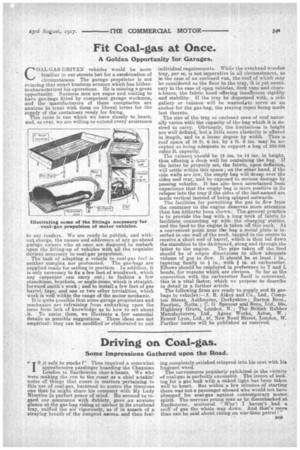Fit Coal-gas at Once. A Golden Opportunity for Gara g es.
Page 15

If you've noticed an error in this article please click here to report it so we can fix it.
COAL-GAS-DRIVEN vehicles would be more familiar in our streets but for a combination of circumstances. The garage proprietor is not evincing that smart business acumen which has hitherto characterized his operations. He is missing a great opportunity. Business men are eager and waiting to have gas-bags fitted by competent garage workmen, and the manufacturers of these receptacles are anxicius to treat with them on liberal terms for the supply of the containers ready for fixing.
This issue is one which we have closely to heart, and, as ever, we are willing to extend every assistance to our readers. We are ready to publish, and withou4 charge, the names and addresses of any go-ahead garage owners who at once are disposed to embark upon the fitting-up of vehicles with all the requisite devices necessary to coal-gas propulsion.
The task of adapting a vehicle to coal-gas fuel is neither complex nor protracted. The -gas-bags are supplied ready for setting in position. In addition, it is only necessary to fix a. few feet of woodwork, which any carpenter can carry out; to fashion a few stanchions, bratkete, or angle-irons, which is straightforward smith's work ; and to install a few feet of gas barrel, _taps, and one or two other trivialities, which work is well within the range of the motor mechanic. It is quite poesible that some garage proprietors and mechanics are refraining from embarking upon the issue from lack of knowledge as to how to set about To assist them, we illustrate a. few essential details as possible suggestions. These ideas are not empirical : they can be modified or elaborated to suit
individual requirements. While the overhead wooden tray, per se, is not imperative in all circumstances, as in the case of an enclosed van, the roof of which may be •considered as the floor to the tray, it is yet necessary in the case of open vehicles, deck vans and charsa-banes, the fabric hood offering insufficient rigidity and stability. If the tray be dispensed with, a side gallery or valance will be wantedato serve as an anchor for the gas-bag, the staying ropes being made fast thereto.
, The size of the tray or enclosed area of roof naturally varies with the capacity of the bag which it is desired to carry. Obviously, the limitatione in height are well defined, but a little more elasticity is offered in length, and to a lesser degree by width. Thus a. roof space of 10 ft. 13 ins. by 4 ft. 6 ins. may be acCepted as-being adequate to support a bag of 260-300 cubic ft. capacity. The valancq 'snould be 12 ins. to 14 ins, in height, thus offering a deep well for containing the bag.II the latter be properly set, the fabric, upon deflation, will settle' within this space ; on the other hand, if the side walls are low, the empty bag will droop over the sides and rear, and be exposed to serious damage by passing vehicles. It has also been ascertained from experience that the empty bag is more punitive in its relapse into the tray if the sides of the last-named are made vertical instead of being splayed outwards.
The facilities for permitting the gas to flow from the container to the engine deserves more attention than has hitherto been shown. The..general practice is to provide the bag with a long neck cif fabric to facilitate connecting up with ,the charging' station, and the feed to the engine is taken off this neck. At a convenient point near the bag a metal plate is inserted in one wall of the neck, tapped in the centre to receive a short end of barrel, which is then led down the stanchion to the dashboard, along and through the latter to the engine. The pipe taken off the feed should be of ample dimersions to allow adequate volume of gas to flow. It ',should be at least 1 in.,
tapering finally to in., with in. at carburetter. Elbows 'should be employed in preference to T and L bends, for reasons which are obvious. So far as the connection with the carburetter Itself is concerned, this is a vital factor, which we propose to describe in detail in a further article.
The following firms are ready to supply and fit gasbags to vehicles :—A. R. Atkey and Co., Ltd. Compton Street, Ashbourne, Derbyshire ; Barton. Bros., Beeston, Notts.; C. G Spencer and Sons, Ltd., 56a, Highbury Grove, London, N.; • The British Rubber Manufacturers, Ltd.,' Agnes Works,. Acton, W. Ernest Lyon, Ltd., 91, New Bond Street, London, WI Further names will be published as received.






















